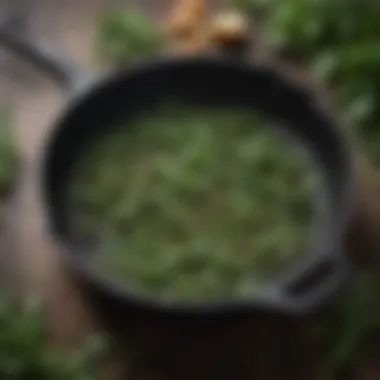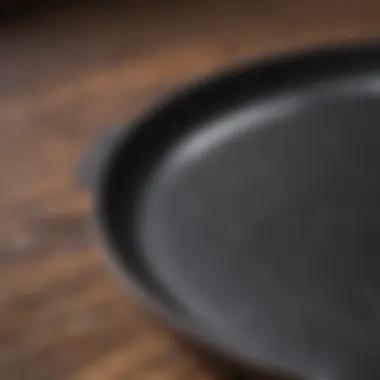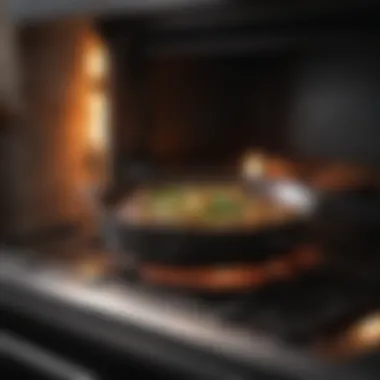Expert Guide on How to Season Cast Iron Skillet After Washing for Optimal Maintenance


Cast iron skillets are essential cookware in any kitchen, known for their durability and ability to distribute heat evenly. However, to maintain their quality and ensure a non-stick surface, it is crucial to season them properly after washing. Seasoning not only helps prevent rust but also enhances the flavor of your dishes. In this detailed guide, we will walk you through the steps to season your cast iron skillet effectively.
Preparing Your Skillet
Before you begin the seasoning process, make sure your cast iron skillet is clean and dry. Use warm water and a brush to remove any food residue, and avoid using soap as it can strip the skillet's seasoning. Once clean, place the skillet on the stovetop over low heat to ensure it is completely dry.
Applying the Seasoning
Once your skillet is dry, it's time to apply the seasoning. Using a paper towel, apply a thin layer of vegetable oil or melted shortening to the entire skillet, including the handle and outer walls. Make sure to cover every inch to create a protective barrier against moisture.
Heating the Skillet
After applying the oil, preheat your oven to a moderate temperature, usually around 350-400°F. Place your skillet upside down on the oven rack to allow any excess oil to drip off. Heating the skillet will help the oil polymerize, forming a natural non-stick coating.
Baking the Skillet
Let the skillet bake in the oven for about an hour. You may notice smoke during this process, which is normal and indicates that the seasoning is forming correctly. After an hour, turn off the oven and let the skillet cool inside. This step ensures the seasoning is properly set and adhered to the skillet's surface.
Final Tips


Once the skillet has cooled, gently wipe off any excess oil with a clean paper towel. Your cast iron skillet is now seasoned and ready to use. Remember that proper maintenance is key to preserving the seasoning, so avoid cooking acidic foods that can break it down. With regular seasoning and care, your cast iron skillet will only improve with time, offering superb cooking results and lasting for generations to come.
How to Season a Cast Iron Skillet After Washing
Introduction
In the culinary world, the cast iron skillet stands as a timeless kitchen essential, prized for its durability and versatility. However, to maintain the pristine quality and functionality of this cookware, proper seasoning is paramount. The process of seasoning involves treating the surface of the cast iron skillet with oil to create a protective layer. This layer not only prevents rusting but also contributes to the development of a natural non-stick surface over time. Understanding how to season a cast iron skillet after washing is crucial for anyone who appreciates the art of cooking and values high-quality kitchen equipment.
Understanding the Importance of Seasoning
To comprehend the significance of seasoning, one must delve into the fundamental chemistry behind the process. Seasoning a cast iron skillet creates a polymerized layer on its surface that acts as a barrier against moisture and corrosive agents. This protective coating not only safeguards the skillet from rust but also enhances its non-stick properties, making cooking and cleaning a seamless experience. By nurturing this seasoned layer, users can enjoy enhanced flavor retention in their dishes and prolonged durability of the skillet.
Benefits of Properly Seasoned Cast Iron Skillet
A properly seasoned cast iron skillet offers a myriad of advantages that elevate the cooking experience. Firstly, the non-stick surface generated through seasoning reduces the chances of food sticking to the skillet, allowing for effortless flipping and transferring of dishes. Moreover, this seasoned layer improves heat retention and distribution, ensuring that food is cooked evenly and retains its flavors. Additionally, a well-seasoned cast iron skillet imparts a unique depth of flavor to dishes over time, gradually infusing essence into every meal prepared.
Materials Needed
Before embarking on the journey of seasoning a cast iron skillet, gather essential materials to facilitate the process. You will require a clean cast iron skillet, preferably free from any food residue or rust. Additionally, choose a high-smoke point oil such as vegetable oil, flaxseed oil, or canola oil for seasoning. Ensure access to paper towels or a lint-free cloth for applying the oil evenly. Lastly, an oven preheated to a specific temperature acts as the final component to complete the seasoning process successfully. Collect these materials, and you are ready to restore your cast iron skillet to its optimal condition.
Step-by-Step Guide to Seasoning a Cast Iron Skillet


Seasoning your cast iron skillet is a crucial step to maintain its quality and enhance its non-stick properties. Proper seasoning not only prevents rust but also ensures that your skillet remains in top condition for years to come. By following this step-by-step guide, you can enjoy cooking with your cast iron skillet while preserving its longevity.
Cleaning the Skillet
Before seasoning your cast iron skillet, make sure to clean it thoroughly to remove any food residue or impurities. You can use a gentle scrub brush and hot water to scrub off any stuck-on particles. Avoid using soap, as it can strip away the skillet's seasoning.
Drying the Skillet Thoroughly
After cleaning, dry the skillet thoroughly using a towel. It's essential to remove all moisture to prevent rust from forming. You can place the skillet over low heat on the stove for a few minutes to ensure it is completely dry.
Preheating the Oven
Preheat your oven to the recommended temperature for seasoning cast iron, usually around 375-400°F (190-200°C). Preheating the oven ensures that the oil you apply to the skillet will form a durable seasoning layer when baked.
Applying Oil to the Skillet
Once the skillet is dry, apply a thin layer of oil to the entire surface, including the handle and exterior. Use a high-smoke-point oil such as vegetable oil or flaxseed oil. Make sure to wipe off any excess oil to avoid a sticky residue after seasoning.
Baking the Skillet
Place the oiled skillet upside down on the middle rack of the preheated oven. Let it bake for about an hour to allow the oil to polymerize and form a strong seasoning layer. This process creates a glossy, non-stick surface on your cast iron skillet.


Cooling and Storing
After baking, turn off the oven and let the skillet cool inside for a couple of hours. Once it has cooled down, your cast iron skillet is ready to use. Store it in a dry place to prevent moisture buildup and maintain its seasoning. Following these steps will help you keep your cast iron skillet in optimal condition for years of enjoyable cooking.
Tips for Maintaining a Seasoned Cast Iron Skillet
In the realm of culinary craftsmanship, caring for your cast iron skillet is an enduring commitment that reaps savory rewards. Once you have navigated through the meticulous process of seasoning your cast iron skillet, utmost care and attention are paramount to prolong its longevity. Maintaining a seasoned cast iron skillet involves eschewing conventional cleaning methods and adopting practices that preserve the cherished seasoning like a culinary connoisseur.
Avoid Using Soap
Lurking inconspicuously in many kitchens, soap poses a grave threat to the integrity of your seasoned cast iron skillet. The harsh chemicals in conventional dish soaps act as scourging agents, stripping away the prized seasoning meticulously built up over time. By abstaining from the use of soap when cleaning your cast iron skillet, you protect its delicate patina and ensure each meal exudes a subtle culmination of flavors, refined through a labor of love.
Regular Re-Seasoning
The art of re-seasoning is a revered ritual in the realm of cast iron cookware. Over time and continued use, the layers of seasoning on your skillet may gradually diminish, rendering it vulnerable to the nefarious advances of rust and degradation. Regular re-seasoning, akin to anointing your skillet with a culinary elixir, fortifies its surface and safeguards its structural integrity. By indulging in the therapeutic ceremony of re-seasoning, you bestow upon your skillet a new lease on life, regaling in its lustrous sheen and velvety touch.
Proper Storage
The denouement of each culinary symphony lies in its epilogue - the storage of your cast iron skillet. As a custodian of fine cookware, the manner in which you store your seasoned skillet determines its enduring quality. To shield your skillet from the caprices of rust and corrosion, ensure it is enshrined in a dry sanctuary, free from the clandestine tendrils of moisture. Embrace the essence of proper storage by bestowing a final caress upon your skillet before it embarks on its respite, securing its legacy for generations to come.
Conclusion
In wrapping up this detailed discourse on how to season a cast iron skillet after washing, it becomes blatantly clear that the final step is crucial for the longevity and performance of this cookware. By adhering to the recommended processes and techniques, you are not only preventing rust but also establishing a formidable non-stick surface that enhances your cooking experience. The significance of concluding the seasoning process diligently cannot be overstated, as it sets the foundation for continued use and maintenance of your cast iron skillet over the years. It is a small yet essential task that reaps immense benefits in terms of durability, usability, and flavor infusion in your culinary endeavors. Therefore, paying attention to the conclusion of seasoning is a testament to your commitment to treating your cast iron skillet with the care and respect it deserves.
Final Thoughts on Seasoning Cast Iron Skillets
As we contemplate the overall process of seasoning cast iron skillets, a few key reflections come to light. Firstly, the act of seasoning is not merely a chore but a ritual that upholds the legacy of cast iron cookware. By consciously avoiding harsh detergents and opting for the gentle touch of oil and heat, you are nurturing a relationship with your skillet that transcends mere functionality. Secondly, the task of seasoning should not be viewed as maintenance alone but as a process of transformation; with each seasoning cycle, your skillet evolves, building a patina that narrates the tales of flavorful dishes gone by. Lastly, the final thoughts on seasoning resonate with a harmony of tradition and modernity, blending age-old practices with contemporary convenience to create a culinary tool that stands the test of time. In essence, seasoning your cast iron skillet is not just about preserving metal; it's about honoring a legacy, crafting memories, and savoring the flavors of the journey.



